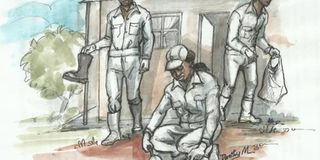Kiruhura murders: What the Government analysts found

Among the physical evidence were blood samples from the deceased, blood samples taken from the accused persons, blood samples from walls of the different rooms in which the bodies were found, a hammer, an iron filing, two spears, soil samples and a controversial pair of gumboots.
The specific objectives of the DNA examination carried out were to; ascertain whether the samples were of human origin, determine if the suspected weapons submitted contained any biological material of the deceased and establish if any of the submitted materials contained biological material of any of the accused persons.
Controversial gumboots
A controversial pair of gumboots dented the credibility of the investigations into the Kiruhura murders and pointed to sheer incompetence and ill motive of the investigators. During the initial investigation, one gumboot apparently stained with blood was found at the scene of crime.
And next to one of the bodies there was an imprint of what the investigators thought was that of a gumboot. The investigators attempted to link this gumboot to one of the accused persons, Fred Nuwagaba, a Rwandese national whose real name was Deudonne Niyomugaba.
The investigators searched the home of Niyomugaba and found a pair of gumboots. Strangely the investigators picked only one of the gumboots, the one of the right foot and even photographed it in the presence of the Niyomugaba.
The two gumboots, one picked from the scene of crime and the other from the abode of the accused, were submitted to the Government Forensic Lab. A senior analyst, when asked about the two gumboots during cross-examination, told court that the two gumboots were not of the same make. One was size 10 and made by Bata while on the other the size number and the maker’s label could not be read.
Other results; some of the materials submitted had no blood stains on them while some tested positive for human blood. DNA profiles were generated from the samples that had blood stains.
However, some of the materials had insufficient DNA. The two spears had blood stains on it but the blood was from one of the deceased. The spear did not have blood from any of the accused persons. There was, therefore, no DNA evidence linking any of the accused persons to the scene of crime. One of the forensic scientists told court that DNA may be destroyed when samples are poorly stored.
Analysis of the soil sample
A government analyst with a master’s qualification in Food Science and Technology carried out the analysis from the various soil samples that were recovered during the investigations. The expert told court that he also had certificates in atomic absorption and forensic spectrometry and these made him competent enough to carry out forensic soil analysis. According to the expert soils defer in their mineral composition and these differences can be used to compare and contrast different soil samples.
The expert received four samples comprising of the controversial pair of gumboots and two soil samples, one from a door and another from the compound of the first wife of the deceased farmer. One of the gumboots did not have any soil on it but was found to contain blood and was accordingly sent to the DNA lab.
The other gumboot was that recovered from the home of one of the accused persons and had soil on it. The analyst told court that he got a soil sample from the back of the sole of the gumboot and that the sample was identical to the soil sample recovered from the door of one of the rooms of the house in which the murders were committed.
To the analyst the two soil samples were similar in mineral composition and to him the similarity was 99.9 per cent. According to the expert the chance that soil samples from two different areas are similar is very low. However, the two similar soil samples were different from the soil got from the compound of the first wife.
The scientist, however, admitted during cross-examination that if a suspect walked a considerable distance it would be possible to find soil samples of different mineral components. And further that on a wet day, the chances are high that the soil will come from the place of last contact.
It was brought out during the trial that it had rained heavily during the night of the murders. The analyst also confessed that he only got 2.8 grams of soil from the gumboot and this is what he used to carry out the analysis.
It emerged during the cross-examination that the gumboot had cow dung on it which could have been a source of contamination.
The analyst admitted that human activity such as gathering of people and vehicles can affect the sampling of soils and the correct procedure is therefore to take soil samples from deep and not from the surface as was the case in these investigations.




